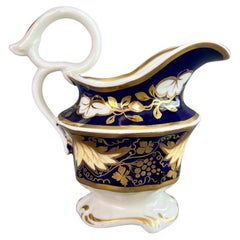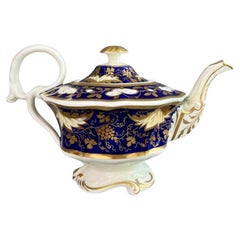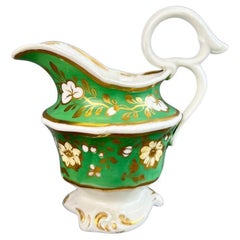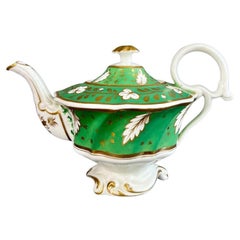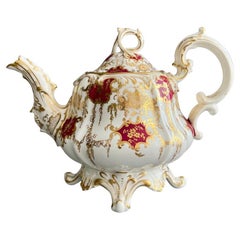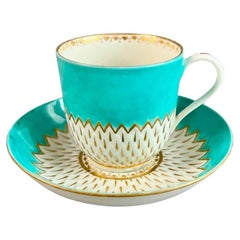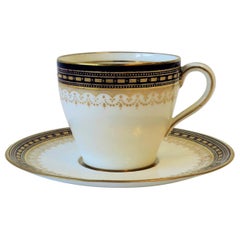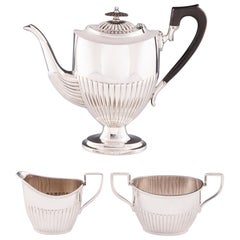Willa Latham Tea Sets
to
23
28
8
20
7
7
2
1
28
27
1
1
28
28
28
27
1
28
28
28
3
2
1
1
1
Samuel Alcock Milk Jug Creamer, Cobalt Blue, Gilt Vines, "Writhen" Shape, ca1826
By Samuel Alcock & Co.
Located in London, GB
A milk jug in the “writhen” shape, cobalt blue ground with white and pale yellow trailing acanthus leaves and vines.
We have a teapot with cover in the same pattern available, pleas...
Category
Antique 1820s English Rococo Revival Porcelain
Materials
Porcelain
Samuel Alcock Teapot, Cobalt Blue with Gilt Vines, "Writhen" Shape, ca 1826
By Samuel Alcock & Co.
Located in London, GB
A teapot with cover in the “writhen” shape, cobalt blue ground with white and pale yellow trailing acanthus leaves and vines.
We have a milk jug in the same pattern available, pleas...
Category
Antique 1820s English Rococo Revival Porcelain
Materials
Porcelain
Samuel Alcock Milk Jug Creamer, Emerald Green "Writhen" Shape, ca 1826
By Samuel Alcock & Co.
Located in London, GB
A milk jug or creamer in the “writhen” shape, emerald green ground with white and pale yellow trailing florals.
We have a milk jug in a nearly identical pattern available, please se...
Category
Antique 1820s English Rococo Revival Porcelain
Materials
Porcelain
Samuel Alcock Teapot, Emerald Green "Writhen" Shape, ca 1826
By Samuel Alcock & Co.
Located in London, GB
A teapot with cover in the “writhen” shape, emerald green ground with white and pale yellow trailing florals.
We have a milk jug in a nearly identical pattern available, please see ...
Category
Antique 1820s English Rococo Revival Porcelain
Materials
Porcelain
Samuel Alcock Teapot, Maroon Pear Shaped Rococo Revival, 1843
By Samuel Alcock & Co.
Located in London, GB
A pear-shaped Rococo Revival teapot with cover, a dramatically scrolled and acanthus moulded foot, spout, loop finial and handle, picked out in gilt. Maroon cartouches and mushroom b...
Category
Antique 1840s English Rococo Revival Porcelain
Materials
Porcelain
Derby Porcelain Coffee Cup, Artichoke Pattern in Turquoise, Georgian ca 1785
By Derby
Located in London, GB
This is a beautiful coffee cup and saucer made by Derby in about 1785. The set has the distinctive "artichoke" moulding and a bright turquoise ground with the white artichoke surface...
Category
Antique 1780s English George III Tea Sets
Materials
Porcelain
$300 Sale Price / set
20% Off
Yates Tea Service, Cobalt Blue, Gilt and Flowers patt. 1038, ca 1825
Located in London, GB
This is beautiful tea service consisting of a teapot with cover, a plate, a slop bowl, four teacups on saucers and four coffee cups on saucers. The service was made by the Yates fact...
Category
Antique 1820s English Regency Tea Sets
Materials
Porcelain
$2,740 Sale Price / set
20% Off
Minton Teacup Trio, Bath Embossed, Green Flowers Patt. 38/680, ca 1830
By Minton
Located in London, GB
This is an elegant "true trio" consisting of a teacup, coffee cup and saucer, made by Minton in about 1830. The set is decorated with the beautifully hand painted pattern no. 680 con...
Category
Antique 1830s English Rococo Revival Tea Sets
Materials
Porcelain
$300 Sale Price / set
20% Off
Samuel Alcock Tearcup Trio, Maroon, Yellow, Gilt and Fine Landscapes, ca 1845
By Samuel Alcock & Co.
Located in London, GB
A true trio consisting of a teacup, a coffee cup and a saucer, “rustic bean” shape, in deep maroon and pale yellow ground, with gilt and finely painted landscape reserves
Pattern 95...
Category
Antique 1840s English Rococo Revival Tea Sets
Materials
Porcelain
$348 Sale Price / set
20% Off
Barr Flight & Barr Teacup, Salmon with Monochrome Sepia Landscapes, ca 1810
By Barr, Flight & Barr Worcester
Located in London, GB
On offer is a very rare teacup and saucer made by Barr Flight & Barr in about 1810. The set has a beautifully soft salmon ground colour, an elegant gilt border motif, and beautiful monochrome sepia landscape...
Category
Antique 1810s English Regency Porcelain
Materials
Porcelain
$1,160 Sale Price / set
20% Off
Pinxton Tea Service, Monochrome Orange Japanese Style Blood & Milk, ca 1800
By William Billingsly
Located in London, GB
Any porcelain made at the Pinxton porcelain factory is rare, but to find a complete tea service is even rarer! This wonderful service was made around...
Category
Antique Early 1800s English Georgian Porcelain
Materials
Porcelain
$4,200 Sale Price / set
20% Off
Derby Coffee Cup, Monochrome Sepia Landscapes Zachariah Boreman, ca 1785
By Derby, Crown Derby
Located in London, GB
This is a very rare and stunning coffee cup and saucer made by Derby in about 1785. The set has a white ground with graceful gilding, and two stunning little landscapes painted by Za...
Category
Antique 1780s English Romantic Tea Sets
Materials
Porcelain
$1,912 Sale Price / set
20% Off
English Pearlware Coffee Pot, Blue Transferware, Fallow Deer in Snow, 1800-1820
Located in London, GB
This is a superb coffee pot made in England between 1800 and 1825. The pot is made of pearlware and has a very charming blue transfer printed pattern of fallow deer in a snowy landscape with farm buildings.
This transfer print looks like an early 19thC print; as we couldn't identify the maker it was impossible to date it exactly. A charming detail is that the rim of the cover and the footrim, which are printed with a row of houses, both are printed up side down; this was probably done by children, who often did the smaller transfer prints because their little fingers could handle the thin strips of paper better than adults.
The coffeepot is unmarked. There is an old shop label on the underside stating it is "English, probably Spode" - however, although this pot is certainly English, it is certainly not Spode.
CONDITION REPORT The coffee pot is in good antique and usable condition without any damage to the pot or the spout; there are just some chips off the lower rim of the cover, which are not visible when in position and are inconsequential for using the pot. As is normal for antique pearlware...
Category
Antique Early 1800s English George III Pottery
Materials
Pearlware
$680 Sale Price / set
20% Off
H&R Daniel Coffee Cup Duo, Plain Shape, White with Landscape, 1825-1830
By H&R Daniel
Located in London, GB
This is an extremely rare and beautiful coffee cup and saucer made by H&R Daniel some time between 1825 and 1830. The set is potted in the "plain" shape and bears pattern no. 4652 wi...
Category
Antique 1820s English Rococo Revival Tea Sets
Materials
Porcelain
$368 Sale Price / set
20% Off
New Hall Hybrid Hard Paste Teacup, Palm Tree patt. 484, Georgian ca 1810
By New Hall
Located in London, GB
This is a beautiful teacup and saucer made by New Hall around the year 1810. The set is decorated in the very desired but rare palm tree pattern with the number 484.
We also have a ...
Category
Antique 1810s English Regency Tea Sets
Materials
Porcelain
$372 Sale Price / set
20% Off
Flight Worcester Teapot Set, Monochrome Print "Ruins" Pattern, Georgian ca 1790
By Flight Worcester
Located in London, GB
This is a beautiful set of a teapot, a sucrier with cover, and a plate made by Worcester in its Flight period, around 1790. You can tell from the generous size of the teapot that it ...
Category
Antique 1790s English George III Porcelain
Materials
Porcelain
$1,276 Sale Price / set
20% Off
Worcester Coffee Cup, Monochrome Black Print "Tea Party no.3", Georgian ca 1760
By 1st Period Worcester Dr. Wall
Located in London, GB
This is a very charming coffee cup and saucer made by Worcester in their First Period (sometimes called the Dr Wall Period) in about 1760. The items are decorated in a black overglaz...
Category
Antique 1760s English George III Porcelain
Materials
Porcelain
$472 Sale Price / set
20% Off
Samuel Alcock Teacup and Milk Jug, Pale Yellow, Gilt and Flowers, ca 1824
By Samuel Alcock & Co.
Located in London, GB
A teacup and saucer with milk jug in the “melted snow” shape with double drop handles, pale yellow ground with rich gilt and cobalt blue acanthus pattern and finely painted flower re...
Category
Antique 1820s English Regency Tea Sets
Materials
Porcelain
$496 Sale Price / set
20% Off
Samuel Alcock Solitaire Tea Set, Cobalt Blue, Gilt Vines and Flowers, ca 1825
By Samuel Alcock & Co.
Located in London, GB
A solitaire tea set consisting of a teapot with cover, a milk jug and a small cup and saucer, in “melted snow” shape, the cup with double drop handle, with deep cobalt blue ground, r...
Category
Antique 1820s English Regency Tea Sets
Materials
Porcelain
$952 Sale Price / set
20% Off
Belleek Cabaret Tea Set for Two, Cream Grass Pattern, Victorian 1863-1891
By Belleek Pottery Ltd.
Located in London, GB
This is a beautiful and very rare Belleek cabaret set in the Grass design, consisting of a teapot, two teacups and saucers, a milk jug and a lidded sugar bowl, all placed on a large tray. All items carry the 1st Black Mark, which was used between 1863 and 1891.
It is extremely rare to come across an entire cabaret set of these antique items, particularly when in such fabulous condition, so this is a rare opportunity!
If you ever thought Belleek fine china looks, sounds and feels unique, you are right. There is a back story to this extraordinarily fine Irish eggshell porcelain, which has an unusually high amount of "frit" and therefore is thinner and finer than any other china.
Pottery in Belleek (in the now Northern-Irish area of Fermanagh) had started in 1849 with John Caldwell Bloomfield, who was a wealthy land owner. During the Irish famine...
Category
Antique Late 19th Century Northern Irish Victorian Tea Sets
Materials
Porcelain
$3,480 Sale Price / set
20% Off
Samuel Alcock Porcelain Teacup, White with Flower Sprays, ca 1823
By Samuel Alcock & Co.
Located in London, GB
A teacup and saucer in the “half orange” shape, white with simple gilt rim and beautiful hand painted flower sprays
Pattern unknown but similar to 1082
Year: ca 1823
Size: cup diameter 10cm (4”), saucer diameter 14.2cm (5.5”)
Condition: excellent, some rubbing to gilt
There are several items available in this design, please see group image and ask for more info if interested.
The Samuel Alcock factory was operative in Staffordshire between 1822 and 1856, after which it was bought by Sir James Duke and Nephews. The factory started as a partnership between the young Samuel Alcock and the older Ralph Stevenson, who provided the factory and capital. Alcock quickly took the factory to great heights, building one of the biggest factories of its time. Alcock jumped on the new Rococo Revival fashion and served a huge new middle class market. The reason we now don't hear much about Samuel Alcock porcelain...
Category
Antique 1820s English Regency Tea Sets
Materials
Porcelain
$292 Sale Price / set
20% Off
Samuel Alcock Matched Solitaire Porcelain Tea Set, Pink with Flowers, ca 1836
By Samuel Alcock & Co.
Located in London, GB
A matched solitaire tea set consisting of a teapot with cover, a sucrier with cover, a milk jug and a matched trio consisting of a teacup, a coffee cup and a saucer. With pink ground...
Category
Antique 1830s English Rococo Revival Tea Sets
Materials
Porcelain
$1,120 Sale Price / set
20% Off
Samuel Alcock Porcelain Teapot, Blue, Gilt and Flowers, Rococo Revival ca 1837
By Samuel Alcock & Co.
Located in London, GB
A teapot with cover in the “rustic bean” shape, cobalt blue ground with gilt acanthus motif and finely painted flower posies on the belly of the teapot
Pattern 5782
Year: ca 1837
Si...
Category
Antique 1830s English Rococo Revival Tea Sets
Materials
Porcelain
$600 Sale Price
20% Off
Bow Porcelain Orphaned Coffee Cup, Famille Rose Peony, circa 1755
By Bow Porcelain
Located in London, GB
This is a very charming orphaned coffee cup made by the Bow Porcelain factory in about 1755. The cup is decorated in a Chinese "famille rose" peony pattern. This cup would have been part of a large tea service, and the tiny size shows how expensive coffee was in the 18th Century.
The Bow Porcelain Factory was one of the first potteries in Britain to make soft paste porcelain, and most probably the very first to use bone ash, which later got perfected by Josiah Spode to what is now the universally used "bone china". Bow was the main competitor of the Chelsea Porcelain Factory, but where Chelsea made very fine slipcast porcelain, Bow made a different soft paste porcelain that tended to be softer and could be pressed into moulds. Bow served a larger public generally at lower prices. The factory was only in operation between 1743 and 1774, after which the tradition got incorporated into some of the later famous potteries such as Worcester and Derby.
The cup is unmarked, which is normal for Bow items of this era.
Condition report the cup is in excellent condition without any damage or repairs. There are various glazing imperfections, which are quite normal for porcelain of this era.
Antique British porcelain...
Category
Antique 1750s English Rococo Tea Sets
Materials
Porcelain
$472 Sale Price
20% Off
New Hall Porcelain Tea Service, Japanese Tobacco Pattern, Georgian, circa 1795
By New Hall
Located in London, GB
This is a stunning tea service made by New Hall in circa 1795. The service is made of hybrid hard paste porcelain and decorated in a bold Chinoiserie pattern of large flower sprays. The service consists of a teapot with cover, a milk jug, a slop bowl, and six tea bowls with saucers.
This service has provenance; it came from the collection of David Redstone, the well known porcelain expert who wrote leading books on Bow and Chelsea porcelain.
The New Hall factory started as a cooperative of several Staffordshire potters making use of the porcelain license of Bristol Porcelain...
Category
Antique 1790s English George III Tea Sets
Materials
Porcelain
$2,320 Sale Price / set
20% Off
Chelsea-Derby Chocolate Cup Set, Gilt Stripes, Puce Flowers, Rococo 1770-1775
By Derby, Chelsea-Derby, Chelsea Porcelain
Located in London, GB
This is a beautiful chocolate cup set made by Chelsea-Derby between 1770 and 1775, which was the Rococo era. The set consists of a cup, a saucer and a cover, and is decorated in a st...
Category
Antique 1770s English Rococo Tea Sets
Materials
Porcelain
$940 Sale Price / set
23% Off
Caughley Porcelain Teapot, Pink Floral Compagnie des Indes, ca 1785
By Caughley Porcelain
Located in London, GB
This is a beautiful teapot made by Caughley around 1785, decorated with the "Compagnie des Indes" pattern with bold pink flower sprays and a pink s...
Category
Antique 1780s English George III Porcelain
Materials
Porcelain
$876 Sale Price / set
20% Off
Spode Porcelain Teacup Trio, Red Imari Dollar Pattern, Regency, ca 1810
By Spode
Located in London, GB
This is a beautiful orphaned teacup made by Spode in about 1810. It bears a lavish Japanese-inspired Imari pattern.
Spode was the great pioneer among the Georgian potters in England. Around the year 1800 he perfected the bone china recipe that has been used by British potters ever since, and he was also the leading potter behind the technique of transferware, making it possible for English potters to replace the Chinese export china, which had come to an end around that time, with their own designs. This was fundamental to a thriving industry that would last for about 150 years and provide half the world with their tableware. Spode porcelain is regarded as one of the highest quality porcelains around; for a soft-paste porcelain it is surprisingly hard and fine, and has a wonderful bright white colour.
The pattern on this can is called "Dollar" pattern, a very famous pattern that was used by English potters in the 18th and early 19th Century. It is obvious why it is called “dollar” - but its origin is less obvious! It is thought that this pattern was derived from a very old Chinese pattern depicting a tree with elaborate foliage that hides a Chinese character representing longevity or happiness. Traditionally, this went with a an image called “Taotie”, which was used on very ancient bronze vases...
Category
Antique Early 1800s English Regency Porcelain
Materials
Porcelain
$420 Sale Price / set
20% Off
Related Items
Royal Doulton White Blue Gold Coffee or Tea Demitasse Cup & Saucer, circa 19th C
By Davis Collamore & Co Ltd. 1, Royal Daulton
Located in New York, NY
A very special English Royal Doulton for luxury retailer Davis Collamore & Co LTD, espresso coffee or tea demitasse cup and saucer set, ci...
Category
Antique Late 19th Century English Tea Sets
Materials
Gold
$675
H 2.38 in Dm 4.5 in
WMF Silver Plate Coffee Pot Sucrier and Milk Jug, c1925
By WMF Württembergische Metallwarenfabrik
Located in Tunbridge Wells, GB
WMF Silver Plate Coffee Pot Sucrier and Milk Jug, c1925
Additional information:
Date : c1925
Period : Victoria or Edward VII (Emperor Wilhelm II)
Marks : GUST.L.HAUER - FRANKFURT A....
Category
20th Century German Victorian Tea Sets
Materials
Silver
Fabergé Porcelain Tea, Coffee Cups Set of Four in a Velvet Case
By Modern Fabergé
Located in North Hollywood, CA
Fine porcelain set of four Fabergé original porcelain coffee or tea cups, service for four.
Enjoy the start to your day with the classical sophistication only from Faberge.
These s...
Category
Late 20th Century French Empire Porcelain
Materials
Porcelain
$1,250 / set
H 12.5 in W 11 in D 5.5 in
Sevres Sky Blue Ground Porcelain Teapot and Cover, Dated 1785
Located in New York, NY
Painter: Vincent Taillandier (1753-90). Gilder; Boileau Le Jeune (1783-89).
Category
Antique 1750s Tea Sets
Materials
Porcelain
Set of Six Cantonese Blue & White Teacups with Saucers 19thC Early 20thC
Located in Port Jervis, NY
Fabulous blue & white Cantonese teacups with Saucers. Late 19thC to early 20thC is the time period. In excellent antique condition with minimal wear. No cracks or chips. Priced and s...
Category
Vintage 1910s Chinese Chinese Export Tea Sets
Materials
Porcelain
Antique Early 19th Century Spode Porcelain Pattern Number 2408 Tea Cup & Saucer
By Spode
Located in Philadelphia, PA
A fine antique Spode porcelain cup & saucer.
Pattern no. 2408
Decorated throughout with a cobalt floral patttern and extensive gilding.
Simply a great cup & saucer from Spod...
Category
Antique Early 19th Century English Neoclassical Porcelain
Materials
Porcelain
$295
H 2.63 in Dm 5.5 in
Richard Ginori Italian Porcelain Espresso Coffee Tea Cup Saucer
By Richard Ginori
Located in New York, NY
A beautiful vintage Italian porcelain espresso coffee or tea demitasse cup and saucer 'Toscana' by designer Richard Ginori, circa mid-20th century, ...
Category
Mid-20th Century Italian Country Porcelain
Materials
Ceramic, Porcelain
Wedgwood Rosso Antico Egyptian Revival Teapot
By Wedgwood
Located in Sarasota, FL
Wedgwood Rosso Antico Egyptian Revival Teapot. The teapot surmounted by figural black crocodile finial, radiating ribbed lid, body decorated with Egypti...
Category
Antique Early 19th Century English Egyptian Revival Porcelain
Materials
Porcelain
Antique 19th C. Derby English Porcelain Shaped Dish in Blue Cornflower Pattern
By Derby
Located in Philadelphia, PA
A fine antique 19th century English porcelain shaped dish.
Decorated throughout with a colorfully painted blue cornflower and gilt accents. The rim features intertwining painted f...
Category
Antique 19th Century English Georgian Porcelain
Materials
Porcelain
$595
H 1.38 in W 10 in D 8.13 in
Georgian Derby Porcelain Plate or Dish Partridge Pattern hand painted, Ca 1815
By Derby
Located in Lincoln, Lincolnshire
This is a very good antique Side / Desert Plate or Dish, made by the Derby factory, hand painted and gilded in the beautiful Partridge Pattern, during the reign of George 111 in the ...
Category
Antique Early 19th Century English Georgian Porcelain
Materials
Porcelain
14-Piece Japanese Gilt and Painted Tea and Dessert Serving Set with Peacock
Located in Norwood, NJ
14-piece Kutani Japanese gilt and painted tea and dessert serving set with Peacock. Hand painted gilt and painted Peacock tea and serving set. Features floral and peacock design.
Lidded tea and coffee pots, lidded creamer, sugar bowl, and five snack sets...
Category
Early 20th Century Japanese Japonisme Tea Sets
Materials
Gold
$975 / set
H 6.75 in W 7 in D 3.5 in
Berlin KPM Porcelain Five-Piece Cobalt-Blue and Parcel-Gilt Coffee Set
By Kerafina Royal Porzellan KPM
Located in Los Angeles, CA
A very fine 19th century Berlin KPM Porcelain Royal five-piece cobalt-blue and 24-carat gold parcel-gilt coffee set. The finely painted and decorated two-serving suite comprising of ...
Category
Antique Late 19th Century German Empire Revival Tea Sets
Materials
Porcelain
$4,850 Sale Price / set
35% Off
H 9.5 in W 10.38 in D 5.38 in
